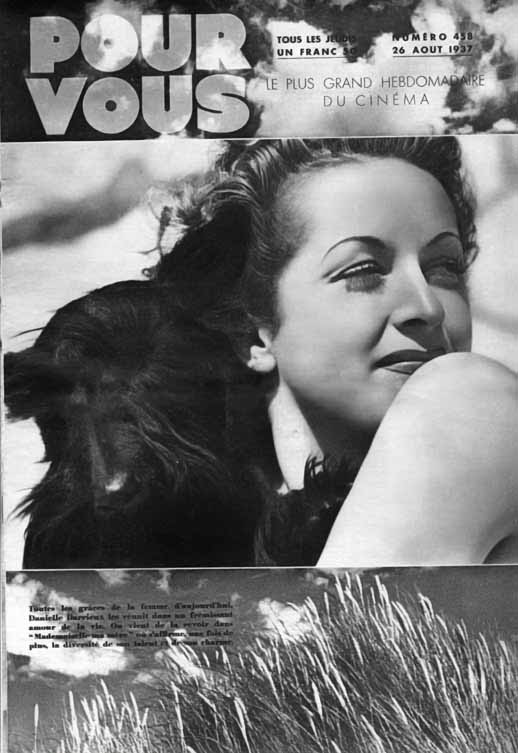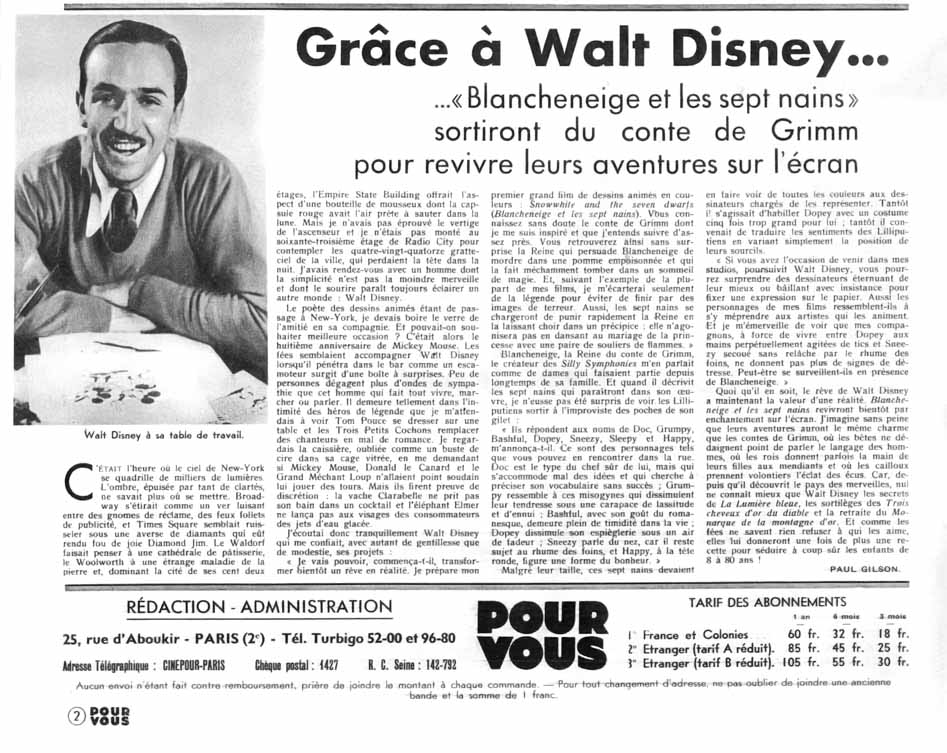The French weekly film magazine Pour Vous (“For You”) was published from November 22, 1928 to June 5, 1940. It is a large-format, lavishly illustrated magazine. Its editorial board, sponsored by L’Intransigeant, was located at 22 rue d’Aboukir, 75002 Paris. In 1937, in the run-up to the release of Snow White and the Seven Dwarfs, the magazine costs 1.50 French Francs per issue.

August 26, 1937
Issue 458 of the French film magazine “Pour vous”, published on August 26, 1937, contains an article on Snow White and the Seven Dwarfs and Walt Disney. There’s also an article on Samson Fainsilber, a somewhat forgotten actor who would go on to provide the French voice of Bambi’s charismatic father a few years later. This magazine testifies to the interest generated by the film in France, even while it was still being made in the studios. Note the spelling “Blancheneige” throughout the article (The final French spelling will be Blanche Neige in the credits). At this point, it’s clear that the dwarfs’ names and personalities have been defined, and that the overly terrifying aspects of the original tale have been left out of the adaptation. Here is the text.
Thanks to Walt Disney… “Snowwhite and the Seven Dwarfs” will leave Grimm’s fairy tale to relive their adventures on screen.
by Paul Gilson (August 26, 1937)
It was the hour when New York’s skies were criss-crossed with thousands of lights. The shadows, exhausted by so much brightness, didn’t know where to put themselves. Broadway stretched like a glow-worm between the gnomes of advertising, the will-o’-the-wisps of publicity, and Times Square seemed to stream under a shower of diamonds that would have driven Diamond Jim mad with joy. The Waldorf reminded me of a pastry cathedral, the Woolworth of a strange stone disease and, towering over the city, the Empire State Building looked like a bottle of bubbly with a red cap ready to jump into the moon. But I hadn’t experienced the vertigo of the elevator, and I hadn’t climbed to the sixty-third floor of Radio City to contemplate the ninety-four skyscrapers of the city, which were losing their heads in the night. I had an appointment with a man whose simplicity is not the least of his marvels, and whose smile always seems to light up another world: Walt Disney. The cartoon poet was visiting New York, so I was to drink the glass of friendship with him. And who could have wished for a better occasion? It was Mickey Mouse’s eighth birthday. Fairies seemed to accompany Walt Disney as he entered the bar like a Jack-in-the-box. Few people radiate more waves of sympathy than this man who makes everything come alive, walk or talk. He’s so intimate with the heroes of legend that I expected Tom Thumb to stand on a table and the Three Little Pigs to replace singers in need of romance. I looked at the cashier, forgotten like a wax bust in her glass cage, wondering if Mickey Mouse, Donald Duck and the Big Bad Wolf were suddenly going to play tricks on her. But they were discreet: Clarabelle Cow didn’t bathe in a cocktail, and Elmer the elephant didn’t throw ice-cold water in the faces of the customers.
So I listened quietly as Walt Disney told me, with as much kindness as modesty, about his plans: “I’ll soon be able to turn a dream into reality. I’m preparing my first major color cartoon film: Snowwhite and the Seven Dwarfs. You’re no doubt familiar with the Grimm fairy tale from which I drew my inspiration, and which I intend to follow quite closely. Unsurprisingly, you’ll find the Queen persuading Snow White to bite into a poisoned apple, causing her to fall into a magical slumber. And, following the example of most of my films, I’ll only deviate from the legend to avoid ending with images of terror. Also, the seven dwarfs will take it upon themselves to swiftly punish the Queen by letting her fall into a precipice: she won’t agonize while dancing at the princess’ wedding in a pair of flaming shoes.” Snowwhite, the Queen of Grimm’s fairy tale, the creator of the Silly Symphonies spoke of them as ladies who had long been part of his family. And when he described the seven dwarfs who would appear in his work, I wouldn’t have been surprised to see the Lilliputians emerge unexpectedly from his vest pockets: “Their names are Doc, Grumpy, Bashful, Dopey, Sneezy, Sleepy and Happy,” he announced. They’re such characters as you might meet on the street. Doc is the type of leader who is sure of himself, but who doesn’t like ideas and who tries to clarify his vocabulary without success; Grumpy resembles those misogynists who hide their tenderness under a shell of weariness and boredom; Bashful, with his taste for romance, remains full of shyness in life; Dopey conceals his mischievousness under an air of blandness; Sneezy talks out of his nose, as he remains prone to hay fever, and Happy, with his round head, figures a form of happiness. ” Despite their size, these seven dwarfs must have been quite a sight to behold for the designers charged with depicting them. Sometimes it was a matter of dressing Dopey in a costume five times too big for him; sometimes it was a matter of translating the Lilliputians’ feelings by simply varying the position of their eyebrows. If you have the opportunity to visit my studios,” continued Walt Disney, “you’ll find artists sneezing as best they can or yawning insistently to fix an expression on paper. So the characters in my films bear a striking resemblance to the artists who bring them to life. And I marvel at the fact that my companions, who live between Dopey, whose hands are perpetually agitated by tics, and Sneezy, who is relentlessly shaken by hay fever, don’t show any more signs of distress. Perhaps they’re keeping an eye on each other in the presence of Snowwhite. Whatever the case, Walt Disney’s dream has now become a reality. Snowwhite and the Seven Dwarfs will soon be magically brought back to life on screen. I can only imagine that their adventures will have the same charm as Grimm’s fairy tales, where beasts do not disdain to speak the language of men, where kings sometimes give their daughters’ hands to beggars, and where pebbles gladly take on the lustre of écus. Ever since he discovered Wonderland, no one knows the secrets of The Blue Light, the spells of The Devil’s Three Golden Hairs and the retreat of The Monarch of the Golden Mountain better than Walt Disney. And as fairies know how to refuse nothing to those who love them, they will once again give him a recipe to seduce children aged 8 to 80!

